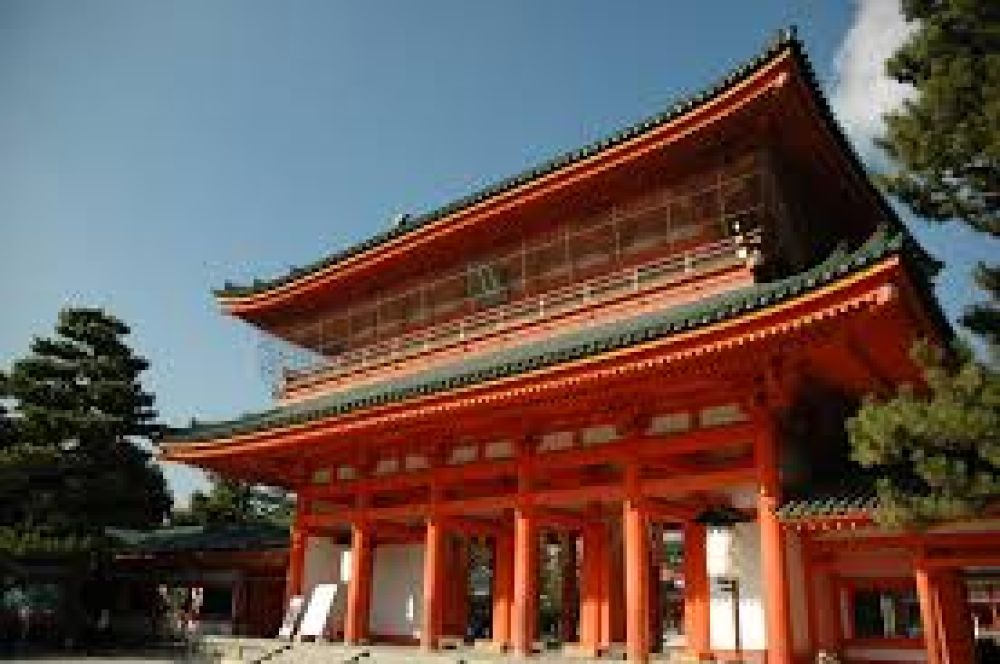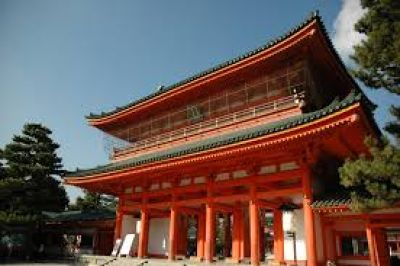

The Heian Shrine is a testament to the beauty and history of Kyoto, and one of its crowning jewels is the Shrine's Garden, or 'Shinen'. This extensive and meticulously maintained space is divided into four parts, each representing the seasons. On the Heian Shrine Garden Tour, visitors will be able to stroll through the lush scenery filled with a variety of plants, ponds teeming with life, and traditional Japanese bridges that offer picturesque views. The East Garden (Higashi Shin'en) is noted for its weeping cherry trees that bloom splendidly in spring. The South Garden (Minami Shin'en) boasts the famous Garyu-kyo (lying dragon bridge) and the West Garden (Nishi Shin'en), which has a serene pond with stepping stone paths. The North Garden (Kitan Shin'en) is the most recent addition and is characterized by its peaceful atmosphere. A visit to each of the gardens provides a moment to reflect on nature's beauty and the changing of seasons, an essential aspect of Japanese culture.
In early spring, the Heian Shrine becomes an ethereal destination for Sakura (cherry blossom) admirers, specifically for its shidarezakura, or weeping cherries. The Weeping Cherry Viewing activity is a seasonal event highly anticipated by both locals and tourists. Visitors not only get to wander beneath trees with cascading pink blossoms but also participate in traditional Sakura viewing known as 'hanami'. Hanami is an age-old Japanese practice of flower viewing that brings people together to enjoy the transient beauty of cherry blossoms. The trees, draped in soft petals, are often lit up in the evenings during the blooming period, creating an enchanting atmosphere. This activity is not just about seeing the flowers, it's about embracing the Japanese spirit of appreciating the moment and the cycle of life, blossoming and fading. The tranquil surroundings of Heian Shrine provide the perfect backdrop for tranquil contemplation or a peaceful picnic under the cherry blossom canopy.
As one of Kyoto's major festivals, the Jingu Taisai Grand Festival at Heian Shrine celebrates the anniversaries of the establishment of Kyoto as the nation's capital and the enshrinement of Emperor Kanmu, who moved the capital to Kyoto. The event, which takes place in October, features an array of cultural activities, including a procession of people dressed in traditional Heian period costumes that parade from the Imperial Palace to Heian Shrine. During this activity, visitors get a glimpse of Japan's rich history reenacted before their eyes. The highlight is the performance of ancient court music and dances, which are designated as Important Intangible Cultural Properties of Japan. Guests can immerse themselves in historical reenactments, partake in festival foods, and enjoy the traditional atmosphere of the shrine. The Jingu Taisai Grand Festival is a vivid display of Kyoto's customs and a reflection of the city's dedication to preserving its heritage.
Heian Shrine is a popular venue for Shinto weddings, known for its impressive architecture and rich symbolism. Visitors can witness traditional Japanese Shinto weddings as couples perform age-old rituals to mark their union. The ceremonies often take place on weekends or auspicious days, set against the backdrop of the shrine's main hall and surrounding gardens. Guests observe from a respectful distance as the bridal procession, often clad in elaborate kimonos and headdresses, make their way through the grounds. The bride and groom are purified, exchange nuptial cups of sake in a ritual called 'san-san-kudo', and offer tamagushi (sacred branches) to the deities. Watching a Shinto wedding is a unique opportunity for visitors to experience a piece of living Japanese culture and tradition, providing a deeper understanding of Japan's social customs and the role of Shintoism in the life milestones of its people.
The Heian Shrine Museum, or 'Treasure House', hosts an exceptional collection of artifacts related to the shrine and the city of Kyoto. Visitors can embark on a journey through history with exhibits that showcase Heian Period art, traditional court costumes, ancient scrolls, and sacred relics that tell the story of the city and the shrine itself. The careful curation of the museum provides an educational experience where one can learn about the architectural evolution of the shrine, the significance of its deities, and the cultural heritage of Kyoto. Highlights include the model display of the original Heian Palace and the ceremonial carriages used in the Jidai Matsuri, one of Kyoto's three great festivals. This activity is a must for any history buff or anyone interested in the traditional arts and cultural practices of Japan.
Engage in a hands-on cultural experience by participating in a calligraphy and amulet making workshop at Heian Shrine. This activity allows visitors to create their personalized 'ema', wooden wishing plaques where one can write prayers or wishes before hanging them at designated spots within the shrine. Under the guidance of local artisans, participants will learn the basics of shodo (Japanese calligraphy) using a brush and ink on paper, before transferring their work onto the ema. Similarly, the workshop delves into the art of creating 'omamori', traditional Japanese amulets believed to provide protection or good luck. The process of creating these cultural pieces is not only meditative but also provides a connection to Japanese spiritual practices, leaving you with a unique and personal souvenir from your visit to Heian Shrine.
Embark on a guided historical tour of Heian Shrine to uncover the rich past and architectural splendors of this important cultural site. The shrine, built in 1895, is dedicated to the spirits of Emperor Kanmu and Emperor Komei. It is a partial reproduction of the Imperial Palace from the Heian Period, marking the 1100th anniversary of the capital's foundation in Kyoto. Visitors on the tour will learn about the site's significance, its role in the preservation of Japanese culture, and its connections to both Shintoism and the people of Kyoto. Knowledgeable guides provide insight into the symbolic elements of the shrine's design, the purpose of various buildings within the complex, such as the Main Hall (Daigoku-den) and the Tower Gate (Oten-mon), and share stories about the customs and festivals associated with Heian Shrine. The tour is an enlightening introduction to this historical landmark and the ancient capital it celebrates.
Throughout the year, Heian Shrine hosts a variety of seasonal festivals and events that provide a glimpse into the traditional calendar of Kyoto. Visitors can participate in these local festivities, each with its unique customs and celebrations. From the cherry blossom viewing in spring to the Jidoustu-e festival in late autumn, where horses are elaborately dressed and paraded around the shrine, each event encapsulates the spirit of the season. During summer, the shrine grounds are a venue for 'Jing? Gaien Hanabi Taikai', a spectacular fireworks display. In the fall, the changing colors of maple leaves in the shrine's garden create a visual feast during the autumnal festival. Taking part in these activities not only entertains but also enriches visitors with a sense of community and the timeless appeal of Kyoto's traditions.
For photography enthusiasts, Heian Shrine offers a feast for the eyes and the lens, with its vibrant vermilion structures, serene landscapes, and rich cultural vignettes. Capture the ornate details of the shrine's architecture, from the majestic Torii gate, one of the largest in Japan, to the intricate carvings and metalwork on the buildings. Photographers can meander through the Japanese-style gardens taking snapshots of the unique flora, traditional stone lanterns, and tranquil ponds. Seasonal changes bring new perspectives, with cherry blossoms in spring, lush greens in summer, fiery maple leaves in autumn, and the quiet beauty of winter snow. This activity provides a chance to improve your photography skills while documenting the serene beauty of the shrine and its surroundings. Remember to be respectful of any ongoing ceremonies or worshippers during your visit.
Experiencing New Year's at Heian Shrine encapsulates a significant cultural and spiritual event for many visitors and locals alike. As one of Japan's most important holidays, New Year, or 'Shogatsu', sees throngs of people visiting the shrine to offer their first prayers of the year, a ritual known as 'hatsumode'. The shrine grounds buzz with activity, filled with special stalls offering 'omikuji' (fortune-telling paper slips), 'omamori' (protection amulets), and a variety of 'osechi-ryori', which are traditional New Year foods. Participants of this activity indulge in festive specialties like hot 'amazake' (a sweet, low-alcohol rice beverage), 'mochi' (pounded rice cakes), and other treats that symbolize good fortune and health in the coming year. The vibrant atmosphere, the sound of bells, and the joyous spirit make celebrating New New Year's at Heian Shrine a memorable and immersive cultural experience.
